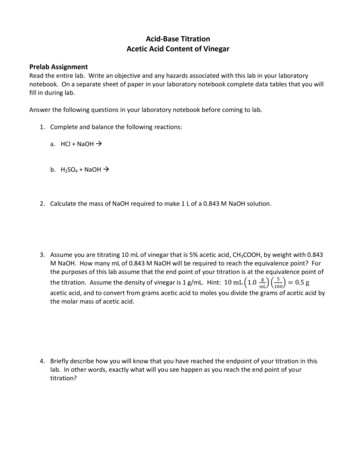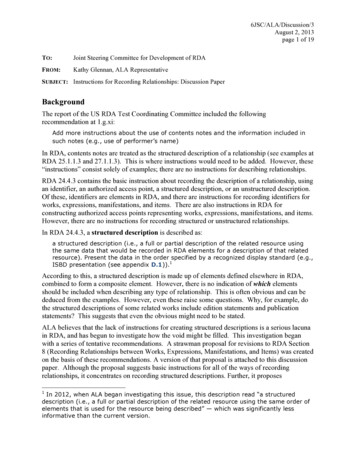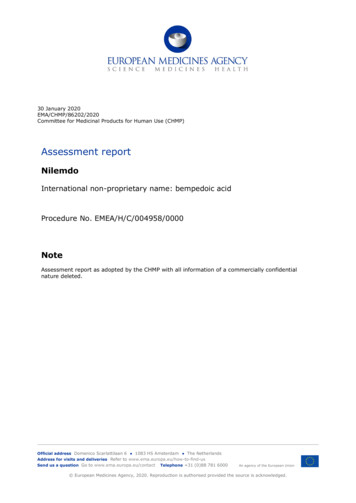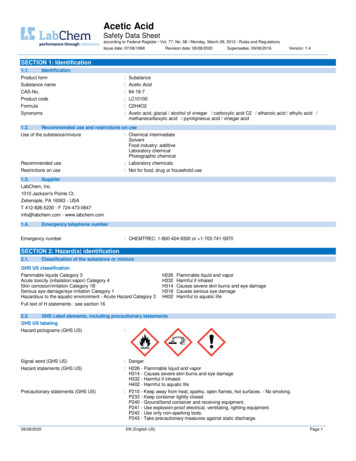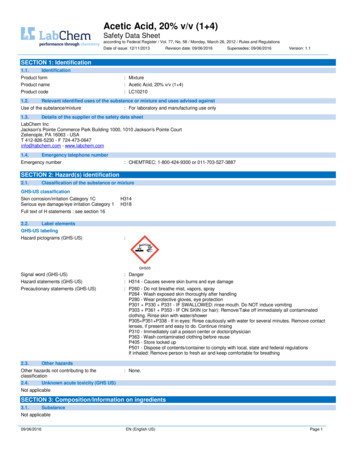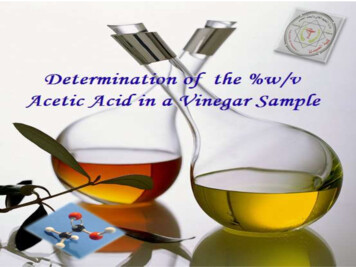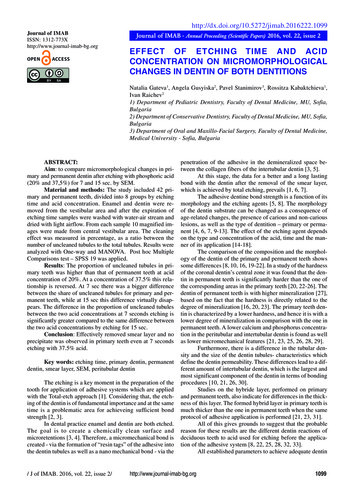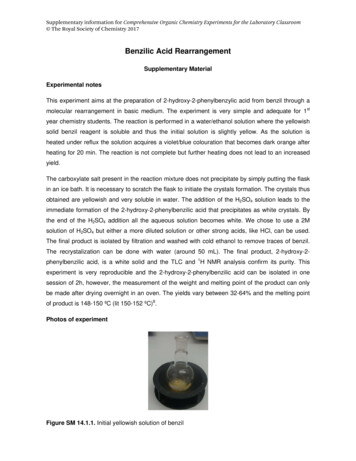
Transcription
Supplementary information for Comprehensive Organic Chemistry Experiments for the Laboratory Classroom The Royal Society of Chemistry 2017Benzilic Acid RearrangementSupplementary MaterialExperimental notesThis experiment aims at the preparation of 2-hydroxy-2-phenylbenzylic acid from benzil through amolecular rearrangement in basic medium. The experiment is very simple and adequate for 1styear chemistry students. The reaction is performed in a water/ethanol solution where the yellowishsolid benzil reagent is soluble and thus the initial solution is slightly yellow. As the solution isheated under reflux the solution acquires a violet/blue colouration that becomes dark orange afterheating for 20 min. The reaction is not complete but further heating does not lead to an increasedyield.The carboxylate salt present in the reaction mixture does not precipitate by simply putting the flaskin an ice bath. It is necessary to scratch the flask to initiate the crystals formation. The crystals thusobtained are yellowish and very soluble in water. The addition of the H2SO4 solution leads to theimmediate formation of the 2-hydroxy-2-phenylbenzilic acid that precipitates as white crystals. Bythe end of the H2SO4 addition all the aqueous solution becomes white. We chose to use a 2Msolution of H2SO4 but either a more diluted solution or other strong acids, like HCl, can be used.The final product is isolated by filtration and washed with cold ethanol to remove traces of benzil.The recrystalization can be done with water (around 50 mL). The final product, 2-hydroxy-2phenylbenzilic acid, is a white solid and the TLC and 1H NMR analysis confirm its purity. Thisexperiment is very reproducible and the 2-hydroxy-2-phenylbenzilic acid can be isolated in onesession of 2h, however, the measurement of the weight and melting point of the product can onlybe made after drying overnight in an oven. The yields vary between 32-64% and the melting pointof product is 148-150 ºC (lit 150-152 ºC)8.Photos of experimentFigure SM 14.1.1. Initial yellowish solution of benzil
Supplementary information for Comprehensive Organic Chemistry Experiments for the Laboratory Classroom The Royal Society of Chemistry 2017Figure SM 14.1.2. Reaction apparatus and the initial violet solution obtained after starting theheatingFigure SM 14.1.3. Reaction mixture after heating for 20 min
Supplementary information for Comprehensive Organic Chemistry Experiments for the Laboratory Classroom The Royal Society of Chemistry 2017Figure SM 14.1.4. Addition of H2SO4 to the carboxylate aqueous solution and formation of the finalproducta)b)Figure SM 14.1.5 - TLC plate. 80% diethyl ether/petroleum ether. a) Benzil b) Product
Supplementary information for Comprehensive Organic Chemistry Experiments for the Laboratory Classroom The Royal Society of Chemistry 20171H NMR and IR SpectraFigure SM 14.1.6. 1H NMR spectrum (400 MHz, CDCl3) of the 2-hydroxy-2-phenylbenzilic acid.100Transmittance er (cm )Figure SM 14.1.7. IR spectra of the 2-hydroxy-2- phenylbenzilic acid500
Supplementary information for Comprehensive Organic Chemistry Experiments for the Laboratory Classroom The Royal Society of Chemistry 2017Preparation of Phenyl Acetate and its Conversionto 4-HydroxyacetophenoneSupplementary MaterialEimíle Sheehy and Paul Evans*Center for Synthesis and Chemical Biology, School of Chemistry and Chemical Biology, UniversityCollege Dublin, Dublin 4, Ireland *Paul.evans@ucd.ieContents:Experiment NotesStep 1: Preparation of phenyl acetate . . .1Step 1: Physical and safety data . .2Step 2: Fries rearrangement: Conversion of phenyl acetate to 4-hydroxyacetophenone 3Step 2: Physical and safety data .4References . forStep2 .7Figure SM 14.2.2.Photo of TLC comparison between phenyl acetate and 4-hydroxyacetophenone.7Figure SM 14.2.3. Photo of different impurity levels present in 4-hydroxyacetophenone afterrecrystallization e . ophenone .91
Supplementary information for Comprehensive Organic Chemistry Experiments for the Laboratory Classroom The Royal Society of Chemistry 2017Figure SM 14.2.6.1H NMR spectrum for a mixture of 2-hydroxyacetophenone, 4-hydroxyacetophen-one and phenyl acetate obtained from a typical Lewis acid (AlCl3) Friesrearrangement .10Figure SM 14.2.7.Infrared spectra for phenyl acetate and 4-hydroxyacetophenone .11Experiment NotesStep 1: Preparation of phenyl acetate:This reaction is rapid and from an experimental perspective, relatively straightforward.Phenol readily dissolves in an excess of basic solution to generate the phenoxide ion.Because this is moderately exothermic we have found that, as directed, cooling the solutionby adding ice-chilled water is beneficial. The subsequent reaction with acetic anhydride ispractically instantaneous and despite a moderate excess of hydroxide the final yield ofphenyl acetate is high. The work-up procedure is also standard and the inclusion of asaturated sodium bicarbonate wash is solely a precaution in case incorrect amounts ofreagents have been added and acetic acid is present following the reaction. If the amountsare correctly measured, as directed, no carbon dioxide evolution is observed. Followingdrying (anhydrous MgSO4 or Na2SO4), filtration and solvent removal under reduced pressurethe phenyl acetate can be reliably distilled using a small, standard distillation apparatus,either at atmospheric pressure (b.pt. approx. 190 C/760 mmHg),1 or under reducedpressure (b.pt. approx. 95 C/20 mm Hg).Reasonable to good (50-80%) yields of acolourless mobile liquid are produced. This part of the experiment has been run successfullyfor several years in our second year undergraduate laboratories (30-60 students per class).Historically, the reaction, the work-up and the distillation was performed on the bench in theopen laboratory, however, more recently the whole experiment has been relocated to fumecupboards. The mechanism of this reaction helps teaching/understanding of pKa values ofalcohols and the resonance of the phenoxide anion, in addition to presenting nucleophilicacyl substitution and the chemistry of the carbonyl group more generally.Physical and safety data Step 1:Phenol: MWt.: 94.11 gmol-1: Causes burns/corrosive, toxic (R 23/24/25; 68); Avoid contactwith skin, wear suitable protective equipment.2
Supplementary information for Comprehensive Organic Chemistry Experiments for the Laboratory Classroom The Royal Society of Chemistry 20174 M NaOH solution: Causes burns/corrosive (R 35); Avoid contact with skin, wear suitableprotective equipment.Acetic anhydride: MWt.: 102.09 gmol-1; d 1.08 gmL-1: Causes burns (R 22); flammable(R 10); harmful (R 20/22); Avoid contact, wear suitable protective equipment.Phenyl acetate MWt.: 136.15 gmol-1; d 1.073 gmL-1; Harmful if swallowed (R 22); Wearsuitable protective equipment. Approx. b.pt. 190 C/760 mm Hg; 95 C/20 mm Hg.Dichloromethane: Limited evidence of a carcinogenic effect (R 40).Sodium hydrogen carbonate solution: Liberates CO2 on ophenone:Conversionofphenylacetateto4-2In a fume cupboard, trifluoromethane sulfonic acid is transferred by syringe to a clean dryround bottom flask (RBF) equipped with a stirrer bar. The flask was cooled externally withan ice-water bath for 5 to 10 minutes before the appropriate amount of phenyl acetate wasadded in a dropwise fashion with another syringe.Under the conditions outlined, thisreaction is fast and proceeds reliably to completion. In addition, only the para-isomer (4isomer) is detected. This is in contrast to alternative methods using Lewis acids, such asAlCl3, and using less polar media, in which typically significant amounts of the 2-isomer areencountered (see for example Figure SM 14.2.6).3 The literature,2 used as a guide for thisexperiment, reports a general procedure using 0.28 mmol of the acetate with 3 mL oftrifluoromethane sulfonic acid. We have found that one can significantly increase the relativeratio of phenyl acetate to trifluoromethane sulfonic acid to the 0.34 mmol to 0.5 mL levelreported in this experiment.However, we have found that attempts to increase theconcentration leads to formation of side-products that are difficult to remove byrecrystallization (see Figure SM 14.2.3). Replacement of trifluoromethane sulfonic acid withalternative Brønsted acids, such as trifluoroacetic acid, proved unsatisfactory.Please note trifluoromethane sulfonic acid is very corrosive so care and careful supervisionshould be taken introducing the trifluoromethane sulfonic acid to both the reaction vesseland the final solution of the reaction product to the separating funnel. These operationsshould only be performed in a fume cupboard. We found that the best way to perform thework-up was, in the fume cupboard, to transfer the contents of the reaction flask to ice3
Supplementary information for Comprehensive Organic Chemistry Experiments for the Laboratory Classroom The Royal Society of Chemistry 2017chilled water in a beaker using a Pasteur pipette.Once this has been performed thecontents of the RBF and the pipette may be safely washed out with dichloromethane andadded to the same beaker. Following a standard extraction process it is recommended todiscard this initial aqueous layer (containing trifluoromethane sulfonic acid) in a separatereceptacle for disposal.Replacement of trifluoromethane sulfonic acid with alternativeBrønsted acids, such as trifluoroacetic acid, proved unsatisfactory.After drying, filtration and evaporation using a rotary evaporator, we found that the materialisolated was rather pure and did not really require additional purification by recrystallization.However, clearly, this is dependent on the purity of the phenyl acetate produced in the initialstep.Should further purification be required the solid can be recrystallized from theminimum volume (ca. 0.3 mmol to ca. 3 mL) of hot toluene. Following this protocol weobtained sharp melting points between 89 and 94 C and a yield (after recrystallization) ofapproximately 80%. Note, the melting points encountered are somewhat lower than thatreported in the literature, albeit using alternative solvent mixtures. However, in our handsuse of this solvent is simpler than the reported alternatives and 1H NMR can also be used toconfirm purity (see Figure SM 14.2.5).4Mechanistically, precise details regarding the Fries rearrangement remain under debate,despite the fact that the reaction was first reported over 100 years ago.5 Under the Brønstedacid-based conditions reported here, using phenyl acetate (1) the 4-isomer (2) is almostexclusively formed. In contrast, using Lewis acidic (typically AlCl3 or BF3), or photochemicalconditions, the 2-isomer (3) is formed in either, substantial amounts,3b or is the exclusiveproduct.6 One explanation for the 2-selectivity involves a tight-ion pair 4, formed during theacyl fragmentation event in the Lewis acid reaction manifold. In contrast, in the Brønstedacid process a phenol and the acylium ion are formed 5, with parallels to Friedel-Craftsacylations (Scheme SM 14.2.1).Scheme SM 14.2.1. Mechanistic pathways for the Fries rearrangement under Lewis, orBrønsted acid mediated reaction conditions4
Supplementary information for Comprehensive Organic Chemistry Experiments for the Laboratory Classroom The Royal Society of Chemistry 2017HOOOOOSOHCF3HAcylium ionand phenol (4)O2X HXOOOOXOOCl3AlAlCl31or HOOSCF3OOOHOOX AlCl3;3HydrolysisCl3AlOCl3AlOOOH(work-up)HTight ion pair (5)OO2Evidence has also been collected to indicate that the Fries rearrangement, under certainconditions, is a reversible process and, thus, arguments of thermodynamic and kineticcontrol may be proposed.5c Finally, the reactive acylium ion may be intercepted by theconjugate base (trifluoromethane sulfonate anion), forming a mixed anhydride. This type ofspecies is known and represents an excellent acylating reagent for Friedel-Craftsprocesses.7Physical and safety data Step 2:Phenyl acetate MWt.: 136.15 gmol-1; d 1.073 gmL-1; Harmful if swallowed (R 22); Wearsuitable protective equipment.4-Hydroxyacetophenone MWt.: 136.15 gmol-1; Harmful if swallowed (R 22); wear suitableprotective equipment and avoid contact.Trifluoromethane sulfonic acid: Causes severe burns (R 35); wear suitable protectiveequipment (“breakthrough time” 0.4 mm nitrile gloves; 188 min). In case of contact washarea well with water and seek medical advice.It is recommended that laboratorysupervisors oversee the dispensing of this material in a fume hood. General spillages canbe neutralised with bicarbonate solutions.5
Supplementary information for Comprehensive Organic Chemistry Experiments for the Laboratory Classroom The Royal Society of Chemistry 2017Dichloromethane: Limited evidence of a carcinogenic effect (R 40).References1. (a) Literature boiling point: 197-198 C (760 mm Hg): A. R. Hajipour and G. Mazloumi,Synth. Commun., 2002, 32, 23. (b) Proton and carbon NMR: B. R. Kim, G. H. Sung, S. –G.Lee and Y. J. Yoon, Tetrahedron, 2013, 69, 3234.2. R. Murashige, Y. Hayashi, S. Ohmori, A. Torii, Y. Aizu, Y. Muto, Y. Murai, Y. Oda and M.Hashimoto, Tetrahedron, 20
This experiment aims at the preparation of 2-hydroxy-2-phenylbenzylic acid from benzil through a molecular rearrangement in basic medium. The experiment is very simple and adequate for 1st year chemistry students. The reaction is performed in a water/ethanol solution where the yellowishFile Size: 2MBPage Count: 80
